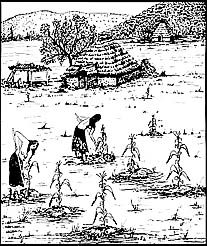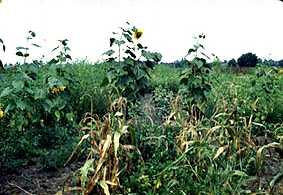
A perennial scene, women at work in the field.

A perennial scene, women at work in the field.
|
For several millenia prior to Mississippian adoption of maize agriculture,
resource exploitation by midwestern Native American had become increasingly
focused on the major river valleys (HDYK-ECON). With increasingly intensive
exploitation of plant and animal resources villages grew in size and were
occupied for longer and longer periods of the year. By the end of the Late
Woodland period most villages were occupied year-round. Fishing and gathering
of wild and cultivated plants on the floodplain were particularly important
subsistence activities by the Late Woodland. Thus, during the Woodland period
in Illinois the cycle of moving residential settlements seasonally to use
resources at various spots on the landscape that had typified Native American
subsistence for the previous 10,000 years gradually gave way to more permanent
settlements and intensive exploitation of renewable resources.
|
|
Although a number of plants were cultivated thousands of years earlier during
the Archaic Period in Illinois (notably marsh elder, goosefoot, squash, bottle
gourd, and sunflower (HDYK-ECON), an expansion of intensive plant utilization
occurred during the Woodland Period when people began to concentrate on
floodplain resources.

Garden with Sunflower and Corn.
The result of this heavier reliance on floodplain plants producing starchy and
oily seeds was an increase in the rate of cultivation. Additional plants
cultivated by the Middle Woodland Period include knotweed, maygrass, little
barley, and tobacco. By A.D. 850 (Emergent Mississippian), an economy based on
crop cultivation and intensive use of wild plant and animals foods was
apperently able to produce a significant and reliable food surplus.
|